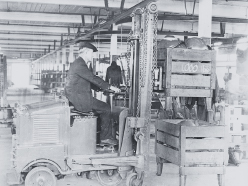The use of pallet racking in the warehouse is currently the most popular storage solution in intralogistics processes. Learn a short history of their development.
YEAR 1871
Development of cardboard packaging
 Cardboard as packaging was used in 1871 when Albert L. Jones patented it as a way to protect vulnerable items. Nearly 20 years later, the concept of two-ply
Cardboard as packaging was used in 1871 when Albert L. Jones patented it as a way to protect vulnerable items. Nearly 20 years later, the concept of two-ply
and three-layer corrugated cardboard, and it wasn’t long before cardboard boxes became popular in Europe and around the world
YEAR 1915
Popularization of forklift trucks
In 1915, forklifts became popular. Various forms of forklifts
forklifts were developed by different companies, but Clark, a manufacturer of gearboxes, and Yale & Towne Manufacturing, a manufacturer of hoists,
have probably created the best versions of this vehicle. In 1923, the the first modern forklift truck appeared. by Yale. When it came to storage and pallet racking, the forklift truck has become an essential piece of the puzzle that made the whole
system worked.
1920S - 1960S
Pallets
The history of the wooden pallet begins with its predecessor, the “skid skid”. The skid was a simple wooden surface on which goods could be stacked or even wheeled. Skids date back to ancient times, with evidence of their existence even dating back to the Egyptians. However, to facilitate the design of wagons, containers, warehouses and, of course, trucks, a single popular size had to be established to suit the maximum number of applications, and at the same time, companies also wanted quality standards so that pallets could be easily exchanged without unloading the goods, on a “normative pallet for normative pallet of goods” basis. And that is why in 1961 the international group of railroad carriers associated in the Union Internationale des Chemins de fer decided to create a 120×80 cm standard, combining it with a 144 millimetre height, defining the EUR standard and quickly making it the most popular pallet type in the world.
LATE 20'S
Pallet Racks
In the late 1920s, the first vertical pallet storage systems began to be used. This development was greatly influenced by the increased demand for storage, the development of forklift trucks and the progressive standardization of pallet sizes. Warehouses could now be expanded upwards rather than outwards, which was much more cost effective . This also changed the way warehouses were built: instead of squat, wide buildings, they were now taller and taller, allowing pallets to be stacked vertically. The first pallet racks only had to hold one layer of pallets, but as
The first pallet racks had to support only one layer of pallets, but as manufacturers built more systems, they designed ways to distribute the weight, which allowed them to create multi-tier pallet racks. Cross beams helped to support heavy pallets, and square vertical frames provided stability for the racks. Of course, strong anchor bolts were also introduced to keep the racks upright.
Regały paletowe są to obecnie najpopularniejsze rozwiązania służące do składowania w procesach intralogistycznych. Poznaj krótką historię ich powstania.
YEAR 1871
Rozwój opakowań tekturowych
 Cardboard as packaging was used in 1871 when Albert L. Jones patented it as a way to protect vulnerable items. Nearly 20 years later, the concept of two-ply
Cardboard as packaging was used in 1871 when Albert L. Jones patented it as a way to protect vulnerable items. Nearly 20 years later, the concept of two-ply
and three-layer corrugated cardboard, and it wasn’t long before cardboard boxes became popular in Europe and around the world
YEAR 1871
Popularization of forklift trucks
In 1915, forklifts became popular. Various forms of forklifts
forklifts were developed by different companies, but Clark, a manufacturer of gearboxes, and Yale & Towne Manufacturing, a manufacturer of hoists,
have probably created the best versions of this vehicle. In 1923, the the first modern forklift truck appeared. by Yale. When it came to storage and pallet racking, the forklift truck has become an essential piece of the puzzle that made the whole
system worked.
1920S - 1960S
Pallets
The history of the wooden pallet begins with its predecessor, the “skid skid”. The skid was a simple wooden surface on which goods could be stacked or even wheeled. Skids date back to ancient times, with evidence of their existence even dating back to the Egyptians. However, to facilitate the design of wagons, containers, warehouses and, of course, trucks, a single popular size had to be established to suit the maximum number of applications, and at the same time, companies also wanted quality standards so that pallets could be easily exchanged without unloading the goods, on a “normative pallet for normative pallet of goods” basis. And that is why in 1961 the international group of railroad carriers associated in the Union Internationale des Chemins de fer decided to create a 120×80 cm standard, combining it with a 144 millimetre height, defining the EUR standard and quickly making it the most popular pallet type in the world.
LATE 20'S
Pallet Racks
In the late 1920s, the first vertical pallet storage systems began to be used. This development was greatly influenced by the increased demand for storage, the development of forklift trucks and the progressive standardization of pallet sizes. Warehouses could now be expanded upwards rather than outwards, which was much more cost effective . This also changed the way warehouses were built: instead of squat, wide buildings, they were now taller and taller, allowing pallets to be stacked vertically. The first pallet racks only had to hold one layer of pallets, but as
The first pallet racks had to support only one layer of pallets, but as manufacturers built more systems, they designed ways to distribute the weight, which allowed them to create multi-tier pallet racks. Cross beams helped to support heavy pallets, and square vertical frames provided stability for the racks. Of course, strong anchor bolts were also introduced to keep the racks upright.
SOURCES:
https://www.1001pallets.com/the-history-of-pallets/Encyclopedia Britannica, 22 Feb. 2019,
https://www.britannica.com/art/calligraphy. Accessed 19 February 2021
